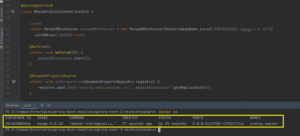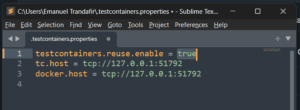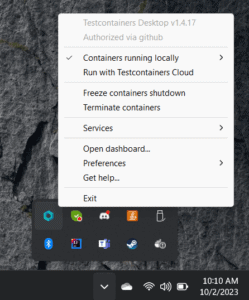1. 概述
在本教程中,我们将学习在设置本地开发和测试环境时如何重用Testcontainers。
首先,我们必须确保在应用程序停止或测试套件完成时不会关闭容器。之后,我们将讨论特定于Testcontainer的配置,并将讨论使用Testcontainers Desktop的好处。最后,我们需要记住,重用Testcontainers是一项实验性功能,尚未准备好在CI管道中使用。
2. 确保Testcontainer没有停止
为我们的单元测试启用Testcontainers的一个简单方法是通过@Testcontainers和@Container注解来利用其专用的JUnit 5扩展。
让我们编写一个测试来启动Spring Boot应用程序并允许它连接到在Docker容器中运行的MongoDB数据库:
@Testcontainers
@SpringBootTest
class ReusableContainersLiveTest {
@Container
static MongoDBContainer mongoDBContainer = new MongoDBContainer(DockerImageName.parse("mongo:4.0.10"));
// dynamic properties and test cases
}
然而,自动启动MongoDBContainer的Testcontainer的JUnit 5扩展也会在测试后将其关闭。因此,让我们删除@Testcontainers和@Container注解,并手动启动容器:
@SpringBootTest
class ReusableContainersLiveTest {
static MongoDBContainer mongoDBContainer = new MongoDBContainer(DockerImageName.parse("mongo:4.0.10"));
@BeforeAll
static void beforeAll() {
mongoDBContainer.start();
}
// dynamic properties and test cases
}
另一方面,我们可能会在本地开发期间使用Spring Boot对Testcontainers的内置支持。在这种情况下,我们不会使用JUnit 5扩展,并且此步骤是不必要的。
3. 管理Testcontainer生命周期
现在,我们可以完全控制容器的生命周期。我们可以将应用程序配置为重用现有的Testcontainer,并且可以从终端手动停止它。
3.1 withReuse()方法
我们可以使用流式API的withReuse()方法将Testcontainer标记为可重用:
static MongoDBContainer mongoDBContainer = new MongoDBContainer(DockerImageName.parse("mongo:4.0.10"))
.withReuse(true);
当我们第一次运行测试时,我们将看到有关启动MongoDBContainer的常见Testcontainers日志,这通常需要几秒钟:
23:56:42.383 [main] INFO tc.mongo:4.0.10 - Creating container for image: mongo:4.0.10
23:56:42.892 [main] INFO tc.mongo:4.0.10 - Container mongo:4.0.10 is starting: d5fa298bf6...
23:56:45.470 [main] INFO tc.mongo:4.0.10 - Container mongo:4.0.10 started in PT3.11239S
测试完成后,我们应该能够看到容器仍在运行。例如,我们可以使用docker ps命令从终端进行检查:
此外,当我们重新运行测试时,只要配置不更改,容器就会被重用。因此,容器设置时间显著减少:
00:12:23.859 [main] INFO tc.mongo:4.0.10 - Creating container for image: mongo:4.0.10
00:12:24.190 [main] INFO tc.mongo:4.0.10 - Reusing container with ID: d5fa298b... and hash: 0702144b...
00:12:24.191 [main] INFO tc.mongo:4.0.10 - Reusing existing container (d5fa298b...) and not creating a new one
00:12:24.398 [main] INFO tc.mongo:4.0.10 - Container mongo:4.0.10 started in PT0.5555088S
最后,重用的数据库包含先前插入的文档。虽然这可能对本地开发有用,但对测试可能有害。如果我们需要重新开始,我们可以在每次测试之前简单地清除集合。
3.2 测试容器配置
在某些情况下,可能会出现警告,指出“Reuse was requested but the environment doesn’t support the reuse of containers”。当我们的本地Testcontainers配置中禁用重用时,就会发生这种情况:
00:23:09.461 [main] INFO tc.mongo:4.0.10 - Creating container for image: mongo:4.0.10
00:23:09.463 [main] WARN tc.mongo:4.0.10 - Reuse was requested but the environment does not support the reuse of containers
To enable reuse of containers, you must set 'testcontainers.reuse.enable=true' in a file located at C:\Users\Emanuel Trandafir\.testcontainers.properties
00:23:09.544 [main] INFO tc.mongo:4.0.10 - Container mongo:4.0.10 is starting: 903dd52d7...
要修复它,我们可以简单地编辑.testcontainers.properties文件并将reuse设置为enabled:
3.3 停止容器
我们可以随时从终端手动停止Docker容器。为此,我们只需运行docker stop命令,然后运行容器ID。应用程序的未来执行会启动一个新的Docker容器。
4. Testcontainers Desktop
我们可以安装Testcontainer Desktop应用程序来轻松管理测试容器的生命周期和配置。
该应用程序需要身份验证,但我们可以使用GitHub帐户轻松登录。登录后,我们将在工具栏中看到“Testcontainers”图标。如果我们点击它,我们将有几个选项可供选择:
现在,执行前面演示的步骤就像单击按钮一样轻松。例如,我们可以通过Preferences > Enable reusable containers轻松启用或禁用可重用容器。此外,如果需要更多调试,我们可以在关闭之前终止容器或冻结它们。
5. 总结
在本文中,我们学习了如何在Java中重用Testcontainers。我们发现JUnit 5可能会在执行完成之前尝试关闭容器,我们通过手动启动容器而不是依赖Testcontainers的JUnit 5扩展来避免这种情况。
之后,我们讨论了withReuse()方法和其他特定于Testcontainer的配置。最后,我们安装了Testcontainers桌面应用程序,并且我们看到了在管理Testcontainers生命周期时它如何成为双重检查配置的宝贵资产。
与往常一样,本教程的完整源代码可在GitHub上获得。
Post Directory



